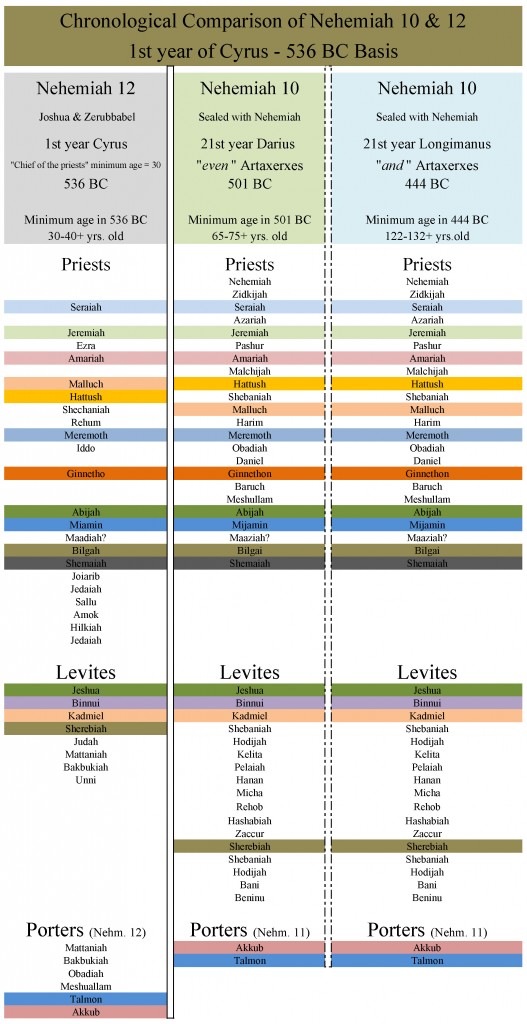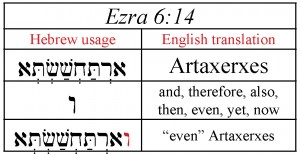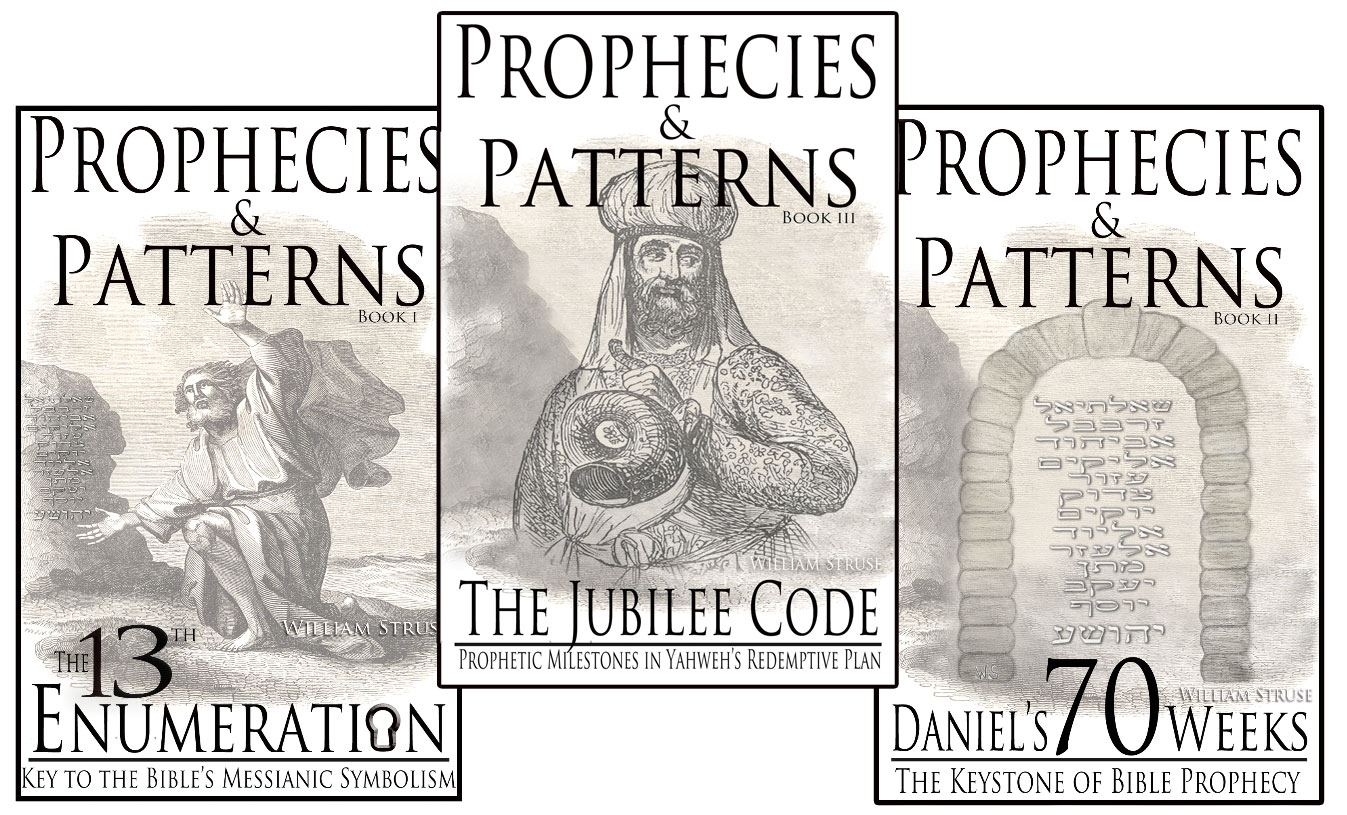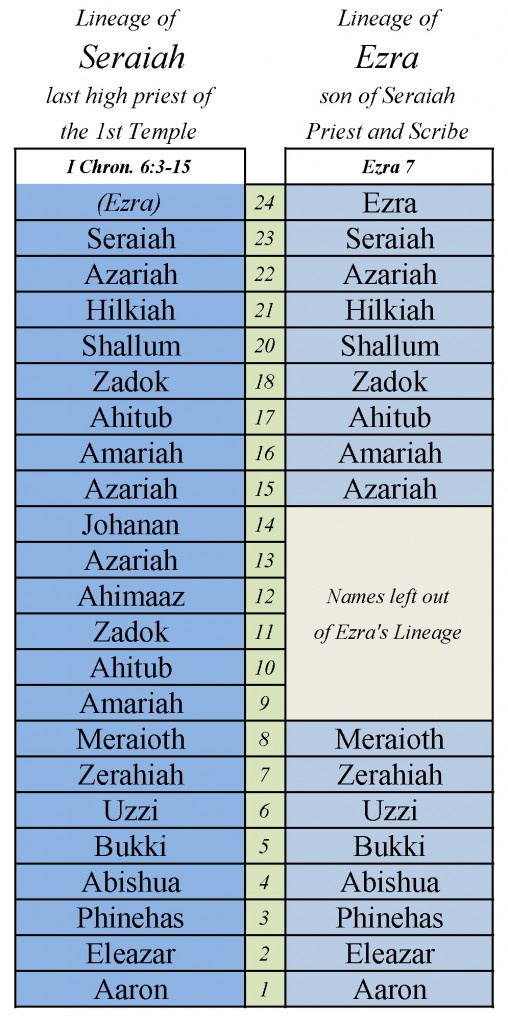 To this day one of the most important, yet least understood aspects of Bible prophecy is the history of Ezra, Nehemiah and their contemporary, the great Persian king “Artaxerxes”. Even less understood is how this history has shaped Continue reading
To this day one of the most important, yet least understood aspects of Bible prophecy is the history of Ezra, Nehemiah and their contemporary, the great Persian king “Artaxerxes”. Even less understood is how this history has shaped Continue reading
Tag Archives: Artaxerxes
Who is the Artaxerxes in Your Prophecy?
 If there is one bit of Biblical history that reaches across the ages to touch the lives of you and me, (besides the death and resurrection of Yeshua) the reign of the Biblical “Artaxerxes” in the book of Ezra would be at the top of the list. You see, in the 2nd temple era the Bible records that a Persian king “Artaxerxes” gave two different decrees which helped the Jewish people build the temple and the city of Jerusalem. Today the majority of Biblical scholars hold that this king was the Persian Longimanus who ruled from 464-424 BC.
If there is one bit of Biblical history that reaches across the ages to touch the lives of you and me, (besides the death and resurrection of Yeshua) the reign of the Biblical “Artaxerxes” in the book of Ezra would be at the top of the list. You see, in the 2nd temple era the Bible records that a Persian king “Artaxerxes” gave two different decrees which helped the Jewish people build the temple and the city of Jerusalem. Today the majority of Biblical scholars hold that this king was the Persian Longimanus who ruled from 464-424 BC.
The reason this is important to you an me is because it is from the reign of this king that most scholars date the start of Daniel 9 and the 70 Weeks countdown to the Messiah. This date then becomes an important pillar in how we understand the future 7 year tribulation, the rapture, the Antichrist and the second coming of Yeshua. Pretty influential date isn’t it? Continue reading
The Jewish Queen of Persia
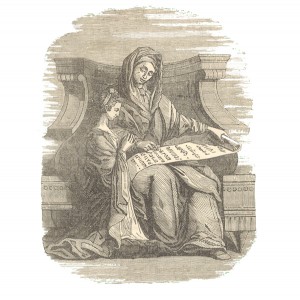 This week is Purim, a celebration that honors YHWH, the living God of the Bible and a young Jewish maiden who changed the course of history. The maiden’s Hebrew name was Hadassah which means myrtle, but most of us know her by her Persian name of Esther or star.
This week is Purim, a celebration that honors YHWH, the living God of the Bible and a young Jewish maiden who changed the course of history. The maiden’s Hebrew name was Hadassah which means myrtle, but most of us know her by her Persian name of Esther or star.
It’s the story of a young girl with a courageous heart who answered the call when others would or could not, a story of one who was willing to sacrifice her place amongst the people she loved in order to protect them. You know, we often focus on Hadassah’s bravery as queen when approaching the king unannounced, but seldom do we appreciate the sacrifice she made for her people long before that day arrived.
You see, Hadassah, in order to be considered a potential future queen of Persia, had to be willing to sacrifice her virtue and her place amongst her own people. This was not just a beauty pageant where the losers got to go home with a consolation prize. The best she could hope for in a second place finish was concubine to the king, forever an outcast without respect and place amongst her own people.
But that is not how it turned out. Hadassah’s bravery and her love for her people changed the history of the Jewish people and those efforts even reached across the ages to touch the lives of you and me. Can you imagine what the history of the Jewish people might have been had Hadassah not acted? To be sure, YHWH could have raised up another brave soul to take her place in order to fulfill His redemptive plan for mankind, but surely the historical landscape would have changed.
Today I’d like to give you a unique glimpse of how YHWH used Hadassah to change the history of the Jewish and Persian people. The history we will explore in this article is a little known aspect of that Jewish / Persian history which finds roots in the superstitions surrounding the number 13 and the celebration of April Fool’s day. Continue reading
A Double Standard for Jonathan Cahn
 In the Bible Jesus often condemned the religious hypocrisy of His day. One of the more vivid examples comes from Matthew 23 where He lectures the scribes and Pharisees, telling them they were “blind guides, which strain at a gnat, and swallow a camel”.
In the Bible Jesus often condemned the religious hypocrisy of His day. One of the more vivid examples comes from Matthew 23 where He lectures the scribes and Pharisees, telling them they were “blind guides, which strain at a gnat, and swallow a camel”.
Lately, I admit that I’m bothered by the way some of Jonathan Cahn’s more strident critics have attacked his work and in some cases his character. Mind you, I’m all for constructive criticism given in the spirit of humility and grace. In fact, there are some parts of Mr. Cahn’s book that I’ve disagreed with myself, but that’s not what I’m talking about here.
What I’m talking about are those who condemn his work with a sense of self-righteous superiority. While Mr. Cahn’s critics are straining to show the illegitimacy of his Shemitah theory, they fail to hold themselves to the same Biblical standard. In fact, I dare say they are straining at a proverbial gnat while swallowing a camel.
This is really about one of the best kept secrets of Bible prophecy. You see, many of Mr. Cahn’s critics hold a prophetic position far more influential for which they cannot provide a solid Biblical foundation. While they accuse Mr. Cahn of insufficient evidence, misinterpretation, and wishful thinking they are guilty of errors far more egregious. I’ll explain: Continue reading
The 70 Weeks of Chuck Missler
 As promised in my last blog article, over the next several weeks, we are going to look at the influence Daniel 9 and the 70 Weeks prophecy has had on the teachings of some of today’s respected prophecy teachers. I want to make it clear up front that these articles, though critical, are not meant to be disrespectful. None of us have all the answers and when discussing Bible prophecy a great deal of humility is required.
As promised in my last blog article, over the next several weeks, we are going to look at the influence Daniel 9 and the 70 Weeks prophecy has had on the teachings of some of today’s respected prophecy teachers. I want to make it clear up front that these articles, though critical, are not meant to be disrespectful. None of us have all the answers and when discussing Bible prophecy a great deal of humility is required.
I decided to start this series by looking at Chuck Missler’s interpretation of Daniel 9. The reason, I start with Mr. Missler’s interpretation of the 70 Weeks, is because this is the predominately held view today and it will be most familiar to a majority of my readers. Mr. Missler is a respected prophecy teacher and I have enjoyed and learned from reading his material over the years. Continue reading
Nehemiah: The Governor
Authors Note: This article is part of an ongoing series on the 2nd temple era chronology as it relates to the prophecy of Daniel’s Seventy Weeks.
Nehemiah: The Governor
In 520 BC YHWH gave Joshua and Zerubbabel a “commandment to restore and build Jerusalem.” (See my article Fifth Command for more information on the subject.) Four years later the temple in Jerusalem was completed but very little progress had been made in building the walls of the ancient citadel. The remnant of people who dwelt there was still being harassed by their enemies.
Back in Shushan, the winter palace of the Persian Kings, a Judean captive named Nehemiah was the cupbearer to king “Artaxerxes”. Nehemiah heard of the plight of his brethren in Jerusalem and set out to do something about it. After pouring his heart out to YHWH in prayer, Nehemiah petitioned king Artaxerxes to allow him to go up and repair the walls of Jerusalem. Artaxerxes granted his request and we learn later that Nehemiah also became governor (Tirshatha) of Jerusalem.
Most scholars today identify the Persian “Artaxerxes” in the book of Nehemiah as Artaxerxes Longimanus. If you have read my articles the Artaxerxes Assumption, or Ezra: Priest & Scribe you know why this identification is without a reasonable basis in the Biblical record. A close look at the information provided in the book of Nehemiah further adds to that conclusion.
In Nehemiah 5:14, it states that Nehemiah was appointed governor from the 20th to the 32nd year of “Artaxerxes”. This information allows us to limit our search for Nehemiah’s “Artaxerxes” to three Persian kings because only three ruled 32 years or longer than. Those kings are Darius, Longimanus, and Memnon. (Memnon ruled 46 yrs. but is not included in the list below. His rule commenced after Darius Nothus)
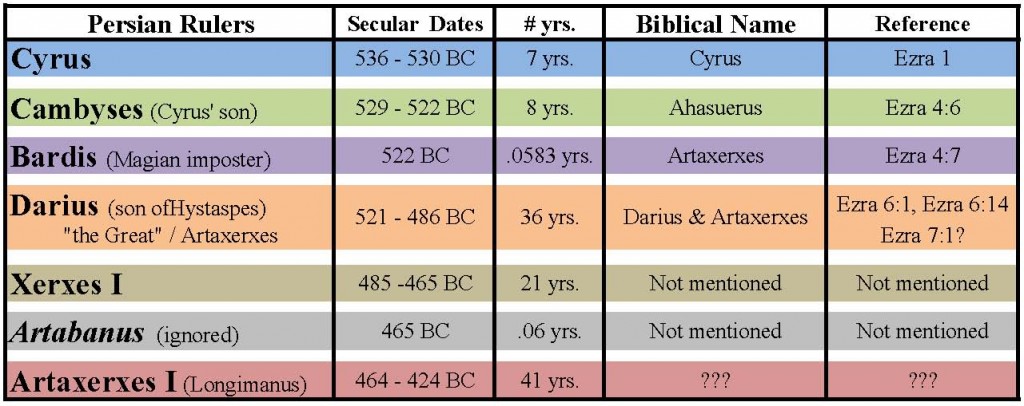
So which of these three Persian kings provides a reasonable basis to claim he is the “Artaxerxes” of Nehemiah? There are several pieces of evidence in the book of Nehemiah which give us the answer so let’s take a look:
- In Nehemiah 1:1 we find Nehemiah in the Shushan palace. For those familiar with the book of Esther you know that Shushan was the palace of Esther’s King. In my articles on the Queen of Persia I showed that in the most reasonable rendering of the Biblical evidence, Esther was the Queen of Darius Hystaspes, king of 127 provinces. This premise is further strengthened by an unusual statement in Neh. 2:6 (Artaxerxes is addressing Nehemiah)And the king said unto me, (the queen also sitting by him,) For how long shall thy journey be? and when wilt thou return?
- Nehemiah 12:25-26 shows a contemporaneous relationship between the porters and Joiakim (son of Jeshua the high priest), Nehemiah, and Ezra. This is important, because this places Nehemiah as a first generation contemporary of those who returned under the mandate of Cyrus in 536 BC.Nehemiah 12:25-26 2Mattaniah, and Bakbukiah, Obadiah, Meshullam, Talmon, Akkub, were porters keeping the ward at the thresholds of the gates. These were in the days of Joiakim the son of Jeshua, the son of Jozadak, and in the days of Nehemiah the governor, and of Ezra the priest, the scribe.
- Nehemiah 12:47 links the governorships of Zerubbabel and Nehemiah and their ministrations to the singers and porters.Nehemiah 12:47 – 13:1 47 And all Israel in the days of Zerubbabel, and in the days of Nehemiah, gave the portions of the singers and the porters, every day his portion: and they sanctified holy things unto the Levites; and the Levites sanctified them unto the children of Aaron.
- In Nehemiah 8 it describes the celebration of the first Feast of Tabernacles which took place after the wall was finished. (21st year of Artaxerxes) The text identifies those who partook:Nehemiah 8:17 17 And all the congregation of them that were come again out of the captivity made booths, and sat under the booths: for since the days of Jeshua the son of Nun unto that day had not the children of Israel done so. And there was very great gladness.
Notice it says “them that were come again out of the captivity”. The most reasonable reading of this implies these people were the same generation as those who came up with Joshua and Zerubbabel in 536 BC. This places them as the contemporary of Darius Hystaspes also known as Artaxerxes. - Further supporting the above is the lists of Nehemiah 10 & 12. In Nehemiah 12 it lists the priests and Levites “chiefs of their fathers” who came up out of the captivity with Joshua and Zerubbabel by the decree of Cyrus in 536 BC. Nehemiah 10 lists many of those same priests and Levites as still alive in the 21st year of “Artaxerxes”.
So which is the more reasonable explanation? These men were (at their youngest) 65-75 years old during the reign of Darius Hystaspes or they were (at their youngest) 122-132 years old during the reign of Artaxerxes Longimanus. Only one of these options does not strain the bounds of credibility. Please see the chart below for comparison.
In summary, it is clear that Nehemiah and Ezra were contemporaries of Darius Hystaspes, also known as Artaxerxes. Any other rendering of the chronology requires one to ignore the most reasonable and natural reading of the book of Nehemiah.
More Articles related to the prophecy of 70 Weeks and 2nd temple era chronology:
The “Artaxerxes” Assumption – The best kept secret of Old Testament chronology.
The Fifth Command – Why do prophecy teachers ignore it?
Ezra: Priest & Scribe – Part I – Defining “Artaxerxes” in the context of Ezra.
Ezra: Priest & Scribe – Part II – Ezra, Darius even “Artaxerxes”.
Nehemiah: The Governor– Nehemiah’s place in the 2nd temple chronology
Queen of Persia – Part I – Defining Esther is the context of the 2nd Temple era.
Queen of Persia – Part II – Defining Esther is the context of the 2nd Temple era.
A New Testament Cipher – The key to unlocking the prophecy of Daniel’s 70 Weeks.
Ezekiel’s 13th Month– Key to understanding Biblical “time” in the 2nd Temple era
6 milestones – Seventy Weeks – Defining the purpose of the Messiah within Daniel’s 70 “weeks”.
The Messiah Factors (Part I): Decoding 13 & 14 – Symbolism of the Messiah
The Messiah Factors (Part II): The Countdown – Proving Yeshua/Jesus is the Messiah promised in Daniel 9.
Ezra: Priest & Scribe – Part II
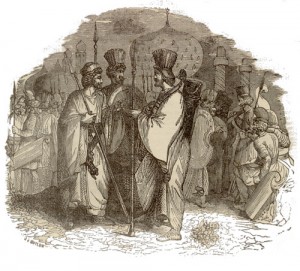 In my previous article Ezra: Priest & Scribe – Part I we learned that the most reasonable explanation of Ezra’s lineage places him as a contemporary of Darius “the Great” son of Hystaspes also known as “Artaxerxes.” Now we will look once again at the chronology of Ezra with this perspective in mind. If Ezra was in fact a contemporary of Darius “the Great” then we should expect additional confirmation from the Old Testament record.
In my previous article Ezra: Priest & Scribe – Part I we learned that the most reasonable explanation of Ezra’s lineage places him as a contemporary of Darius “the Great” son of Hystaspes also known as “Artaxerxes.” Now we will look once again at the chronology of Ezra with this perspective in mind. If Ezra was in fact a contemporary of Darius “the Great” then we should expect additional confirmation from the Old Testament record.
For those who are not familiar with the chronology of the 2nd temple era, it is worth briefly going over it once more to establish the context. In 536 BC, Cyrus gave a decree which allowed the Judean captives to return and build the Temple in Jerusalem. Ezra 1:1-3 tells of these events. Incidentally, for those willing to dig a little deeper, the Cyrus Cylinder found in the ruins of Babylon also offers some intriguing confirmation of Ezra’s record below.
Ezra 1:1-3 Now in the first year of Cyrus king of Persia, that the word of YHWH by the mouth of Jeremiah might be fulfilled, YHWH stirred up the spirit of Cyrus king of Persia….. Thus saith Cyrus king of Persia, YHWH God of heaven ….. he hath charged me to build him an house at Jerusalem…. Who is there among you of all his people? his God be with him, and let him go up to Jerusalem, which is in Judah, and build the house of YHWH God of Israel, (he is the God,) which is in Jerusalem.
As I explained in my article The Fifth Command for the next 16 years the enemies of the Jewish people harassed them in their efforts to build the temple. In fact they did not get much further than laying some of the foundation stones.
The chart below is a summary of the Persian rulers from Cyrus to Artaxerxes I. It will provide a handy reference for those trying to figure out how the Persian kings related to the 2nd temple era chronology.

In 520 BC (2nd yr. of Darius), YHWH gave the Judean captives a divine command “to restore and build Jerusalem.” Joshua, the high priest, and Zerubbabel, the governor, listened to the words of YHWH as witnessed by the prophets Haggai and Zechariah and construction on the temple resumed. (Ezra 6:14) Four years later, the temple was finished in the 6th year of Darius.
Now here is where modern Biblical scholarship takes a detour. Ezra 6 ends with the completion of the 2nd temple in the 6th year of Darius.(516 BC) Ezra 7 starts with Ezra, the priest & scribe, setting off on his journey to Jerusalem in the 7th year of “Artaxerxes.”
Today, most Biblical scholars have assumed that this “Artaxerxes” is a reference to Artaxerxes I (Longimanus). This requires them to insert a gap of about 58 years between Ezra 6 & 7. They do this despite the fact that Darius (son of Hystaspes) is in fact called “Artaxerxes” in Ezra 6:14. Let’s take a look.
Ezra 6:14-15 14 And the elders of the Jews builded, and they prospered through the prophesying of Haggai the prophet and Zechariah the son of Iddo. And they builded, and finished it, according to the commandment of the God of Israel, and according to the commandment of Cyrus, and Darius, {and} Artaxerxes king of Persia. 15 And this house was finished on the third day of the month Adar, which was in the sixth year of the reign of Darius the king.
It is imperative to note in the verses above, that it clearly states the Jewish people “builded and finished” the temple according to the “commandments” of God of Israel, Cyrus, Darius and Artaxerxes king of Persia. Notice it states unequivocally that the temple was finished by the 6th year of Darius. That means all the secular rulers mentioned in Ezra 6:14 must have ruled at some point previous to the 6th year of Darius.
Who then is the “and Artaxerxes” mentioned in Ezra 6:14? It couldn’t be the “Artaxerxes” of Ezra 4:7 because this “Artaxerxes” stopped construction of the temple. Who then could it be? Many Biblical scholars have assumed, contrary to the clear context of the verse, that this “Artaxerxes” is a reference to Artaxerxes I – Longimanus. This despite the fact that he reigned almost 60 years after the temple was completed.
Most likely the translators use a single Hebrew letter to further the “Artaxerxes Assumption.” In Hebrew, the letter waw, is often used as a conjunction but as most Hebrew lexicons explain it also has a much wider, though less common, use as well. Below is the TWOT Hebrew lexicon explaining the use of waw.
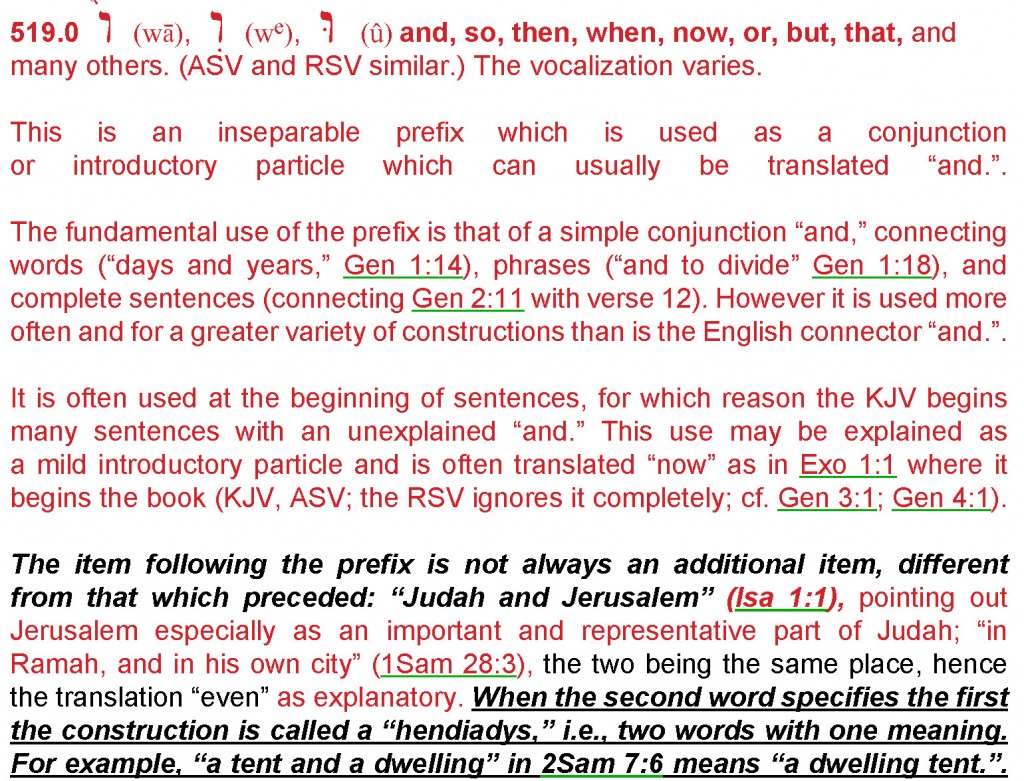 For those who read the entire excerpt you saw the waw can also be used as a “hendiadys,” i.e. two words with one meaning. Take a look at the little chart below. It shows waw as it appears in the Hebrew text of Ezra 6:14.
For those who read the entire excerpt you saw the waw can also be used as a “hendiadys,” i.e. two words with one meaning. Take a look at the little chart below. It shows waw as it appears in the Hebrew text of Ezra 6:14.
Ezra 6:14-15 14 And the elders of the Jews builded, and they prospered through the prophesying of Haggai the prophet and Zechariah the son of Iddo. And they builded, and finished it, according to the commandment of the God of Israel, and according to the commandment of Cyrus, and Darius, and even Artaxerxes king of Persia.
Since there is no reasonable basis to assume the “Artaxerxes” of Ezra 6:14 was another Persian king the translators should have used waw as a hendiadys not a conjunction. Their decision to use the waw as a conjunction was premised upon the necessity to show that Ezra was a contemporary of Artaxerxes Longimanus. There is simply no other reason to add another Persian king to the chronology of Ezra 6:14-15. I encourage you to work it out yourself.
Now take a look at the Ezra 6 and 7 in this context. In the 6th year of Darius “even” Artaxerxes the 2nd temple is completed. Just a few verses later it shows that the temple had been completed and Ezra decided to go up to Jerusalem and teach the people the Torah. Ezra 7 states he received permission to go up to Jerusalem in the 7th year of “Artaxerxes.” With what we now know, this is perfectly reasonable. No need for another Persian king and a gap of 58 years. Ezra simply went up to Jerusalem in the 7th year of Darius also known as Artaxerxes. This confirms the Biblical evidence concerning Ezra’s lineage as we saw in Ezra: Priest & Scribe – Part I. This also has far reaching implications for Bible prophecy teachers who hold to the “Artaxerxes Assumption”.
Those of you who have the heart of a Berean, I encourage you to search this out for yourselves. For those of you too proud or stubborn to look, I humbly ask you to reconsider. The uncomfortable implications of this can no longer be ignored as too much is at stake.
FREE Book Download:
If you would like to learn more about Biblical history and Bible prophecy, you might also appreciate my books in the Prophecies and Patterns series.
At the following link you may download one of the three books shown below. If you like the book and would like to download the other two, all I ask is that you subscribe to my blog. I won’t share your email or spam you with advertisements or other requests. Just every couple of weeks I’ll share with you my love of Biblical history and Bible Prophecy. Should you decide you no longer wish to be a subscriber you can unsubscribe at any time.
Click the following link to download your Free book: Book Download
I hope you’ll join the adventure!
[DISPLAY_ULTIMATE_PLUS]
More Articles related to the prophecy of 70 Weeks and 2nd temple era chronology:
The “Artaxerxes” Assumption – The best kept secret of Old Testament chronology.
The Fifth Command – Why do prophecy teachers ignore it?
Ezra: Priest & Scribe – Part I – Defining “Artaxerxes” in the context of Ezra.
Ezra: Priest & Scribe – Part II – Ezra, Darius even “Artaxerxes”.
Nehemiah: The Governor– Nehemiah’s place in the 2nd temple chronology
Queen of Persia – Part I – Defining Esther is the context of the 2nd Temple era.
Queen of Persia – Part II – Defining Esther is the context of the 2nd Temple era.
A New Testament Cipher – The key to unlocking the prophecy of Daniel’s 70 Weeks.
Ezekiel’s 13th Month– Key to understanding Biblical “time” in the 2nd Temple era
6 milestones – Seventy Weeks – Defining the purpose of the Messiah within Daniel’s 70 “weeks”.
The Messiah Factors (Part I): Decoding 13 & 14 – Symbolism of the Messiah
The Messiah Factors (Part II): The Countdown – Proving Yeshua/Jesus is the Messiah promised in Daniel 9.
Ezra: Priest & Scribe – Part I
 During the 2nd temple period, few Old Testament characters hold a more prominent position than Ezra. The Bible identifies him as a Priest and Scribe. It is believed that he was the author of both the book of Ezra as well as Chronicles. Both of these accounts provide a vivid record of the triumphs and tragedies of the Judean captives’ efforts in rebuilding the 2nd temple and Jerusalem. After the completion of the temple in the 6th year of Darius, Ezra, who still resided in Persia, saw the need to return to Jerusalem and teach the people the law of YHWH.
During the 2nd temple period, few Old Testament characters hold a more prominent position than Ezra. The Bible identifies him as a Priest and Scribe. It is believed that he was the author of both the book of Ezra as well as Chronicles. Both of these accounts provide a vivid record of the triumphs and tragedies of the Judean captives’ efforts in rebuilding the 2nd temple and Jerusalem. After the completion of the temple in the 6th year of Darius, Ezra, who still resided in Persia, saw the need to return to Jerusalem and teach the people the law of YHWH.
Today, the chronology of Ezra is an important cornerstone for most of today’s teachings on Daniel 9, the greatest Messianic prophecy in the Bible. Daniel 9, also known as the prophecy of “seventy weeks,” is the only prophecy in the Bible that specifically links a dateable secular event with the coming of the Messiah. Daniel 9:25 states the following:
Daniel 9:25 25 Know therefore and understand, that from the going forth of the commandment to restore and to build Jerusalem unto the Messiah the Prince shall be seven weeks,
Without the chronology of Ezra, there would be no way to determine the starting point for “the commandment to restore and to build Jerusalem.” (For more on the subject see my articles The Fifth Command and The “Artaxerxes Assumption”.) Considering the importance of Ezra’s writings to our understanding of the Seventy Weeks prophecy you might assume this Old Testament chronology would be well established upon a reasonable Biblical basis. For those who have taken the time to look, you will find instead it is one of the best kept secrets of Old Testament chronology.
Do you find that hard to believe? I encourage you to see for yourself. Choose any of today’s most respected teachers on the prophecy of Seventy Weeks and see what reasonable Biblical evidence they provide to show Ezra was a contemporary of “Artaxerxes” Longimanus. To be sure you will find their “Artaxerxes Assumption” but what you will not find is any reasonable Biblical evidence to support it.
So what does the Bible say about Ezra?
It may surprise you to learn there is substantial Biblical evidence to determine Ezra’s place in 2nd temple era chronology. Probably the best place to start is in the beginning.
Ezra 7:1 Now after these things, in the reign of Artaxerxes king of Persia, Ezra the son of Seraiah, the son of Azariah, the son of Hilkiah,
In the verse above, it says that Ezra was the son of Seraiah. What’s fascinating about this statement is Seraiah, son of Azariah, was the last high priest of Solomon’s temple. 2 Kings 25:8-21 tells us that Seraiah was taken by Nebuzaradan to Riblah in the 19th year of Nebuchadnezzar and there he was killed.
2 Kings 25:1-21 8 And in the fifth month, on the seventh day of the month, which is the nineteenth year of king Nebuchadnezzar king of Babylon, came Nebuzaradan, captain of the guard, a servant of the king of Babylon, unto Jerusalem: 9 And he burnt the house of YHWH, and the king’s house, and all the houses of Jerusalem, and every great man’s house burnt he with fire. 10 And all the army of the Chaldees, that were with the captain of the guard, brake down the walls of Jerusalem round about. 11 Now the rest of the people that were left in the city, and the fugitives that fell away to the king of Babylon, with the remnant of the multitude, did Nebuzaradan the captain of the guard carry away………..18 And the captain of the guard took Seraiah the chief priest, and Zephaniah the second priest, and the three keepers of the door…………. 20 And Nebuzaradan captain of the guard took these, and brought them to the king of Babylon to Riblah: 21 And the king of Babylon smote them, and slew them at Riblah in the land of Hamath. So Judah was carried away out of their land.
I think most everyone would agree, it is reasonable to assume that Ezra could not have been conceived after the death of his father, Seraiah. Let’s further assume, for the sake of argument, that Ezra was born the year his father was killed. (Not really a reasonable assumption considering the events that took place in Jerusalem but it’s the earliest he could have been born so let’s go with it) The 19th year of Nebuchadnezzar by many accounts was 584 BC.
Ezra 7:1-8 Now after these things……… This Ezra went up from Babylon;……. unto Jerusalem, in the seventh year of Artaxerxes the king. 8 And he came to Jerusalem in the fifth month, which was in the seventh year of the king.
In order to establish Ezra’s place in the chronology of the 2nd Temple era all we now need to do is determine the date for the 7th year of “Artaxerxes”. If you’ve read my articles The Fifth Command and The “Artaxerxes Assumption you know that the term “Artaxerxes” is simply a title which was applied to several Persian kings. For the sake of brevity, I will not list all the possible Persian Artaxerxes, only those whose reign lasted at least 32 years as required by Nehemiah 5:14. Those Persian kings are Darius “the Great” Artaxerxes, Artaxerxes Longimanus, and Artaxerxes Memnon. With the above information, it is a simple matter to calculate Ezra’s minimum age during the reign of “Artaxerxes”. In the table below you will see the youngest Ezra could have been in the 7th year of each “Artaxerxes”. Please keep in mind that Ezra was also alive 14 year later at the dedication of the wall in Jerusalem and took an active part in those ceremonies.
The question is simple: Which of the above Persian Kings most reasonably qualifies as a contemporary of Ezra? Keep in mind the words of king David:
Psalm 90:9-10 9 For all our days are passed away in thy wrath: we spend our years as a tale that is told. 10 The days of our years are threescore years and ten; and if by reason of strength they be fourscore years, yet is their strength labour and sorrow; for it is soon cut off, and we fly away.
In my next article, Ezra the Priest and Scribe – Part II we will look at the chronology of Ezra 6 &7. What does the Bible say about the 7th year of “Artaxerxes” and who does it identify as this “Artaxerxes”? Why is this relevant to the prophecy of Seventy Weeks?
More Articles related to the prophecy of 70 Weeks and 2nd temple era chronology:
The “Artaxerxes” Assumption – The best kept secret of Old Testament chronology.
The Fifth Command – Why do prophecy teachers ignore it?
Ezra: Priest & Scribe – Part I – Defining “Artaxerxes” in the context of Ezra.
Ezra: Priest & Scribe – Part II – Ezra, Darius even “Artaxerxes”.
Nehemiah: The Governor– Nehemiah’s place in the 2nd temple chronology
Queen of Persia – Part I – Defining Esther is the context of the 2nd Temple era.
Queen of Persia – Part II – Defining Esther is the context of the 2nd Temple era.
A New Testament Cipher – The key to unlocking the prophecy of Daniel’s 70 Weeks.
Ezekiel’s 13th Month– Key to understanding Biblical “time” in the 2nd Temple era
6 milestones – Seventy Weeks – Defining the purpose of the Messiah within Daniel’s 70 “weeks”.
The Messiah Factors (Part I): Decoding 13 & 14 – Symbolism of the Messiah
The Messiah Factors (Part II): The Countdown – Proving Yeshua/Jesus is the Messiah promised in Daniel 9.
The “Artaxerxes” Assumption
” Those Jews who took Herod for the Messiah, and were thence called Herodians, seem to have grounded their opinion upon the seventy weeks of years, which they found between the Reign of Cyrus and that of Herod: but afterwards, in applying the Prophesy to Theudas, and Judas of Galilee, and at length to Barchochab, they seem to have shortened the Reign of the Kingdom of Persia.”
Anyone care to guess who made the quote above? Would you believe that one of the most famous scientists of all time penned this in the early 1700’s? It may come as a surprise to some that Sir Isaac Newton had a great interest in the Bible and Biblical prophecy. It was in his Chronology of Ancient Kingdoms Amended, as quoted above, where he noticed the Jewish chronology was missing a couple of centuries. What’s fascinating is he traced the root of that missing chronology to an assumption made by early Jewish messianic expectants concerning the most important prophecy in the Bible.
It is worth considering the importance of that for a moment. Over two thousand years ago Jewish messianic believers made an assumption about the prophecy of 70 Weeks (found in the book of Daniel chapter 9) which led them to erase over two hundred years of history. Ironically, Christian scholars today have made a similar mistake only instead of erasing two hundred years of chronology they have added seventy years. What is most amazing about these chronological errors is that they are both based in what could be called an “Artaxerxes Assumption.”
For over two millennia, the holy grail of messianic prophecies has been the prophecy of “70 Weeks” found in chapter 9 of the book of Daniel. This is the only prophecy in the entire Biblical record which gives a specific datable event as a marker for the future appearance of the Messiah. As quoted above, Isaac Newton believed the prophecy was in part responsible for over two hundred years of missing Persian chronology. Though he was correct in tracing the missing chronology to an erroneous assumption concerning the prophecy of 70 weeks, Newton was incorrect in attributing that error to a starting point in the reign of Cyrus.
To get to the real root of the problem it is imperative to understand the prophecy within the context of the 2nd temple era of Jewish history. The starting point for the prophecy of Daniel 9 (which was the basis for each of the failed messianic claims noted by Newton) began with a “commandment to restore and to build Jerusalem”.
Daniel 9:25 25 Know therefore and understand, that from the going forth of the commandment to restore and to build Jerusalem unto the Messiah the Prince shall be seven weeks,
As explained in my article The Fifth Command there was only one “commandment to restore and to build Jerusalem” the Jewish people would have recognized. That command was the Divine command given by YHWH, proclaimed by Haggai and Zechariah and witnessed by Ezra 6:14 (see my article The Fifth Command for further explanation).
Here is how the “Artaxerxes Assumption” enters the picture. The Divine command “to restore and to build Jerusalem” was given in the 2nd year of Darius who was also known historically as “Artaxerxes”. When the Asmonaeans calculated the 70 weeks of Daniel from the 2nd year of Darius it allowed them to claim that Judas Maccabaeus was the promised messiah. When he failed to usher in the Messianic kingdom, the prophecy was recycled for the next Jewish messianic figure. Since the Divine command was given in the 2nd year of Darius “Artaxerxes” the next generation of Jewish messianic expectants just shifted the prophecy to the 2nd year of another Persian Artaxerxes. With the end of the Bar Cochab rebellion in the first part of the 2nd century the use of Daniel 9 to claim the start of the Messianic kingdom had run its course. The Rabbinic Biblical calendar was reset and 241 years of Persian history were lost.
To this day the Rabbinic Biblical calendar still reflects this mistake. Unfortunately, the “Artaxerxes Assumption” of the 1st centuries set in motion the chronological confusion which is still alive today. As a result of these errors, the only legitimate and contextually accurate fulfillment of the Prophecy of Seventy Weeks was obscured and eventually all but forgotten.
Around the turn of the twentieth century, a Scotland Yard investigator named Sir Robert Anderson (of Jack the Ripper fame) wrote a book on the prophecy of Daniel 9 called The Coming Prince. In his work on this great prophecy, Anderson made his own “Artaxerxes Assumption.” This time instead of erasing the Persian chronology, Anderson stretched the Biblical chronology of Ezra and Nehemiah by 58 years in order to fulfill his interpretation of the prophecy of 70 weeks. Today, Anderson’s interpretation is the basis for most scholars’ writings on the subject of Daniel 9. Regrettably, his good intentions were a little short on reasonable chronological evidence from the Bible.
First, Anderson ignored the contextual relevance of YHWH’s command “to restore and to build Jerusalem.” Unlike his 1st century messianic predecessors, Anderson saw no reason to begin the prophecy with the words of YHWH. Next, Anderson assumed the “Artaxerxes” of Nehemiah and Ezra was Artaxerxes Longimanus. Unfortunately, he did not base this assumption upon any Biblical evidence but instead upon a single unsubstantiated opinion of the Christian historian, Rawlinson, in his translation of Herodotus, vol. 4, p.217 . That quote as taken from Anderson’s The Coming Prince is as follows:
Artaxerxes I. reigned forty years, from 465 to 425. He is mentioned by Herodotus once (6. 98), by Thucydides frequently. Both writers were his contemporaries. There is every reason to believe that he was the king who sent Ezra and Nehemiah to Jerusalem, and sanctioned the restoration of the fortifications.” – RAWLINSON, Herodotus, vol. 4., p. 217.
Anderson, by all accounts, was an exceptional Biblical scholar. To be fair to Anderson, his assumption was understandable considering Ussher, Newton, Rawlinson, and Josephus were of the same general opinion concerning “Artaxerxes.” I mean, what kind of person argues with the opinion of some of the greatest Biblical chronologists of all time? Okay, I must admit I am raising my hand timidly from the back of the room. But with all due respect to these great men, it seemed to have been a case of each thinking the other had done his homework. In this case, their messianic zeal caused them to make an assumption which is unsupported by Biblical chronology. I appreciate the fact that they believed Ezra and Nehemiah were contemporaries of Artaxerxes Longimanus, but is that sufficient proof upon which to establish the most important prophecy in the Scripture? Kind of hard to believe, isn’t it? I encourage you to check it out for yourself. The Coming Prince can be read at Rapture Ready, one of the most respected Bible prophecy web sites on the internet. Here is what they say about Sir Robert Anderson and The Coming Prince:
“He helped establish the fact that 69 of Daniel’s 70 weeks have now transpired, and that the tribulation will be the 70th week. Sir Robert Anderson’s book, The Coming Prince, has become a foundational resource for all dispensationalists.”
With all due respect to the good folks over at Rapture Ready how can a belief about Daniel’s 70 weeks be an established “fact” when the “foundational resource” is based upon an assumption with no reasonable basis in Biblical chronology?
In closing, I would like to encourage those of you interested in Bible prophecy to check out the Biblical chronological evidence, before you make your own unfounded “Artaxerxes Assumption.”
More Articles related to the prophecy of 70 Weeks and 2nd temple era chronology:
The “Artaxerxes” Assumption – The best kept secret of Old Testament chronology.
The Fifth Command – Why do prophecy teachers ignore it?
Ezra: Priest & Scribe – Part I – Defining “Artaxerxes” in the context of Ezra.
Ezra: Priest & Scribe – Part II – Ezra, Darius even “Artaxerxes”.
Nehemiah: The Governor– Nehemiah’s place in the 2nd temple chronology
Queen of Persia – Part I – Defining Esther is the context of the 2nd Temple era.
Queen of Persia – Part II – Defining Esther is the context of the 2nd Temple era.
A New Testament Cipher – The key to unlocking the prophecy of Daniel’s 70 Weeks.
Ezekiel’s 13th Month– Key to understanding Biblical “time” in the 2nd Temple era
6 milestones – Seventy Weeks – Defining the purpose of the Messiah within Daniel’s 70 “weeks”.
The Messiah Factors (Part I): Decoding 13 & 14 – Symbolism of the Messiah
The Messiah Factors (Part II): The Countdown – Proving Yeshua/Jesus is the Messiah promised in Daniel 9.
The Fifth Command
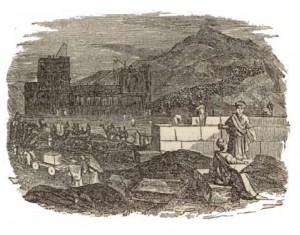
In the 1st year of the Median king, Ahasuerus, a Judean captive named Daniel was given a prophecy concerning events which were going to happen to his people and to the city of Jerusalem. He was told the prophecy would commence with a “commandment to restore and to build Jerusalem.”
Daniel 9:25 25 Know therefore and understand, that from the going forth of the commandment to restore and to build Jerusalem unto the Messiah the Prince shall be seven weeks.
2500 years removed from the time of Daniel, we see the history of that era in a different light than the people who lived it. How do you think they would have recognized the “commandment to restore and to build”? What would they have looked for? Whose command would they have recognized? From the perspective of the returning captives, what act would have constituted the building of Jerusalem? If we want to understand the prophecy of Daniel 9 we must understand it in the context it was given.
Today most scholars identify four possible commands which they believe qualify as a “commandment to restore and to build Jerusalem.”
- The decree by Cyrus in 536 BC (To rebuild the temple and Jerusalem)
- The decree by Darius (son of Hystaspes) the “Great” in 520 BC (To restart construction of the temple)
- The decree by “Artaxerxes” in his 7th year (given to Ezra to return to Jerusalem)
- The decree by “Artaxerxes” in his 21st year (granting Nehemiah permission to build the wall of Jerusalem)
Some claim the first two “commands” are disqualified because they refer to the building of the temple and have nothing to do with building Jerusalem. I would ask if building the temple was not the de facto event in building Jerusalem, what event would have constituted it? As you will see in the verses below, building the Temple was in fact “building Jerusalem”.
First, let’s look at Daniel 9:25 a little closer: Have any of you ever wondered why the verse says “restore” and “build”? A look at the origins of the word “restore” brings some insight to the verse. “Restore” is the Hebrew word shuwb and its primary meaning is to return or turn back. When Daniel 9:25 is read in this light, it offers another perspective on how the early Judeans might have understood the commandment to return (shuwb) and to build (banah) Jerusalem.
In 536 BC, Cyrus gave the initial decree that allowed the Jews to go up to Jerusalem and build the temple. The enemies of the Jews harassed them for the next 16 years, so instead of building the temple the people worked on their own houses. What some today may not realize but the enemies of the Jews knew without a doubt was that Jerusalem was nothing without the house of YHWH. To them building the Temple of YHWH was building Jerusalem.
KJVEzra 4:1-5 Now when the adversaries of Judah and Benjamin heard that the children of the captivity builded the temple unto YHWH God of Israel;……… Then the people of the land weakened the hands of the people of Judah, and troubled them in building, 5 And hired counsellors against them, to frustrate their purpose, all the days of Cyrus king of Persia, even until the reign of Darius king of Persia.
According to the decree of Artaxerxes (Bardis the Magian usurper) building the temple was building Jerusalem.
Ezra 4:21-24 21 Give ye now commandment to cause these men to cease, and that this city be not builded, until another commandment shall be given from me. 22 Take heed now that ye fail not to do this: why should damage grow to the hurt of the kings? 23 Now when the copy of king Artaxerxes’ letter was read before Rehum, and Shimshai the scribe, and their companions, they went up in haste to Jerusalem unto the Jews, and made them to cease by force and power. 24 Then ceased the work of the house of God which is at Jerusalem. So it ceased unto the second year of the reign of Darius king of Persia.
There is another underlying dynamic which is not obvious with just a casual observation of these events. Even though YHWH stirred up Cyrus to allow the Jews to return to Jerusalem and build the temple, (thus ending the 70 years of Jeremiah) it was not until the 2nd year of Darius that YHWH’s divine anger ended. (See Zech 1:12-17 below) When YHWH’s anger towards the people finally ended He commanded them to return and build the temple.
KJVZechariah 1:7-17 7 Upon the four and twentieth day of the eleventh month, which is the month Sebat, in the second year of Darius, came the word of YHWH unto Zechariah, ……12 Then the angel of YHWH answered and said, O YHWH of hosts, how long wilt thou not have mercy on Jerusalem and on the cities of Judah, against which thou hast had indignation these threescore and ten years? 13 And YHWH answered the angel that talked with me with good words and comfortable words. 14 So the angel that communed with me said unto me, Cry thou, saying, Thus saith YHWH of hosts; I am jealous for Jerusalem and for Zion with a great jealousy. 15 And I am very sore displeased with the heathen that are at ease: for I was but a little displeased, and they helped forward the affliction. 16 Therefore thus saith YHWH; I am returned to Jerusalem with mercies: my house shall be built in it, saith YHWH of hosts, and a line shall be stretched forth upon Jerusalem. 17 Cry yet, saying, Thus saith YHWH of hosts; My cities through prosperity shall yet be spread abroad; and YHWH shall yet comfort Zion, and shall yet choose Jerusalem.
Just to make sure the people got His point YHWH expressed similar sentiments to Haggai:
KJVHaggai 1:1-9 In the second year of Darius the king….came the word of YHWH by Haggai the prophet unto Zerubbabel …..and to Joshua the son of Josedech, the high priest, saying, 2 Thus speaketh YHWH of hosts, saying, This people say, The time is not come, the time that YHWH’S house should be built…. Is it time for you, O ye, to dwell in your cieled houses, and this house lie waste? 5 Now therefore thus saith YHWH of hosts; Consider your ways. 6 Ye have sown much, and bring in little; ye eat, but ye have not enough; ye drink, but ye are not filled with drink; ye clothe you, but there is none warm; and he that earneth wages earneth wages to put it into a bag with holes. 7 Thus saith YHWH of hosts; Consider your ways. 8 Go up to the mountain, and bring wood, and build the house; and I will take pleasure in it, and I will be glorified, saith YHWH. 9 Ye looked for much, and, lo, it came to little; and when ye brought it home, I did blow upon it. Why? saith YHWH of hosts. Because of mine house that is waste, and ye run every man unto his own house.
The whole matter was summarized by Ezra 6:14:
KJVEzra 6:14 14 And the elders of the Jews builded, and they prospered through the prophesying of Haggai the prophet and Zechariah the son of Iddo. And they builded, and finished it, according to the commandment of the God of Israel, and according to the commandment of Cyrus, and Darius, even Artaxerxes king of Persia.
Now let’s look at Daniel 9:25 as Daniel’s people would have understood it:
KJVDaniel 9:25 25 Know therefore and understand, that from the going forth of the commandment to return (shuwb) and to build (banah) Jerusalem unto the Messiah the Prince shall be seven weeks.
Regardless of what we believe about Daniel 9, there was only one commandment the Jewish people would have recognized. Only one command they would have acknowledged. That is the “commandment to return and to build Jerusalem” given by YHWH, proclaimed by Haggai and Zechariah and witness by Ezra 6:14.
16 Therefore thus saith YHWH; I am returned (shuwb) to Jerusalem with mercies: my house shall be built (banah) in it, saith YHWH of hosts, and a line shall be stretched forth upon Jerusalem. KJVZechariah 1:16
Why have we ignored the Fifth Command?
The “Artaxerxes” Assumption – The best kept secret of Old Testament chronology.
The Fifth Command – Why do prophecy teachers ignore it?
Ezra: Priest & Scribe – Part I – Defining “Artaxerxes” in the context of Ezra.
Ezra: Priest & Scribe – Part II – Ezra, Darius even “Artaxerxes”.
Nehemiah: The Governor– Nehemiah’s place in the 2nd temple chronology
Queen of Persia – Part I – Defining Esther is the context of the 2nd Temple era.
Queen of Persia – Part II – Defining Esther is the context of the 2nd Temple era.
A New Testament Cipher – The key to unlocking the prophecy of Daniel’s 70 Weeks.
Ezekiel’s 13th Month– Key to understanding Biblical “time” in the 2nd Temple era
6 milestones – Seventy Weeks – Defining the purpose of the Messiah within Daniel’s 70 “weeks”.
The Messiah Factors (Part I): Decoding 13 & 14 – Symbolism of the Messiah
The Messiah Factors (Part II): The Countdown – Proving Yeshua/Jesus is the Messiah promised in Daniel 9.
Open Letter to Prophecy Teachers – RE: Daniel 9
An Open Letter To Arno Froese, Chuck Missler, David Reagan, Dave Hunt, Tim LaHaye , Hal Lindsey, Todd Strandberg, Terry James, Jack Kelley, Sean Osborne
Dear Prophecy Teachers,
Just over twenty years ago, I attended my first prophecy conference in Orlando, Florida. My mother, bless her heart, knew of my interest in Bible prophecy and for my eighteenth birthday she bought me a plane ticket to the Orlando conference. That gift and the subsequent weekend was, in part, the catalyst for a lifelong love of Biblical history and Bible prophecy. I will never forget stepping into the conference room that first day and realizing I was the only young person there. That fact was the impetus for one of the highlights of that day; during lunch break that day, Arno Froese and Texe Marrs invited me to lunch. Their graciousness and genuine interest was something I will never forget.
Gentlemen, some of you are considered the patriarchs of Bible prophecy of my generation. If there is one point, besides the expectation of Yeshua’s return, that you have stressed over the years it was that each of us are responsible, as Bereans, to search the Scriptures to see if what you’ve taught is based upon a sound Scriptural foundation. That admonishment is the reason for this letter.
Of all the prophecies in the Bible, Daniel’s Seventy Weeks (Daniel 9), is the only one which links the coming of the Messiah with specific dateable events. This prophecy is also a cornerstone for a large part of today’s eschatological thought. Without Daniel 9, we would have to reconsider much of what we believe about the 7 year “covenant,” the “tribulation,“ and the “anti-christ.” Our understanding of the Book of Revelation would also have to be changed. To put it bluntly, without the prophecy of Seventy Weeks most of us would not recognize Bible prophecy as we know it today.
This brings me to a troubling question concerning many of the teachings on Daniel 9. Most lay the chronological foundation for Daniel 9 upon the belief that Ezra and Nehemiah were contemporaries of “Artaxerxes” Longimanus. Considering this chronology is the foundational premise of most interpretations, it would be reasonable to assume its factual basis would be established on a footing commensurate with its importance. How many have adequately addressed the following Scriptural challenges the chronology of Ezra and Nehemiah present to the premise that Artaxerxes = Longimanus:
- Ezra 6:13-14
- The two “Artaxerxes” in the book of Ezra. (One of them was an imposter)
- Historically Darius “the Great” was known as “Artaxerxes”.
- The natural chronological flow between Ezra 6 & 7
- The death of Ezra’s father Seraiah.
- The age of the Jewish leaders who returned with Joshua and Zerubabbel
- Talmon and Akkub the porters.
- The contemporaneous relationship of Ezra and the high priests.
- The “Queen” mentioned in Nehemiah
Gentlemen, the evidence shows that by no reasonable rendering of the Old Testament chronological facts could Ezra and Nehemiah have been contemporaries of “Artaxerxes” Longimanus. It is time to deal with the implications of the evidence. Surely, the greatest messianic prophecy of the Scripture deserves a better foundation than the one it has been given.
In closing, let me say that at no point in the past forty one years of my life have I been more convinced that we are living in the generation that will see the literal return of Yeshua. I also believe, despite the challenges which need to be addressed above, Daniel 9 and the Seventy Weeks prophecy proves beyond a reasonable doubt that Yeshua is the Messiah promised in the Scriptures.
Sincerely,
William Struse
Authors Note: Over the coming weeks I will be writing a series of articles on the 2nd temple era chronology as it relates to Daniel 9 and the Seventy Weeks prophecy.
The “Artaxerxes” Assumption – The best kept secret of Old Testament chronology.
The Fifth Command – Why do prophecy teachers ignore it?
Ezra: Priest & Scribe – Part I – Defining “Artaxerxes” in the context of Ezra.
Ezra: Priest & Scribe – Part II – Ezra, Darius even “Artaxerxes”.
Nehemiah: The Governor– Nehemiah’s place in the 2nd temple chronology
Queen of Persia – Part I – Defining Esther is the context of the 2nd Temple era.
Queen of Persia – Part II – Defining Esther is the context of the 2nd Temple era.
A New Testament Cipher – The key to unlocking the prophecy of Daniel’s 70 Weeks.
Ezekiel’s 13th Month– Key to understanding Biblical “time” in the 2nd Temple era
6 milestones – Seventy Weeks – Defining the purpose of the Messiah within Daniel’s 70 “weeks”.
The Messiah Factors (Part I): Decoding 13 & 14 – Symbolism of the Messiah
The Messiah Factors (Part II): The Countdown – Proving Yeshua/Jesus is the Messiah promised in Daniel 9.

